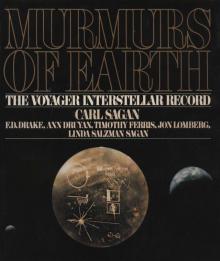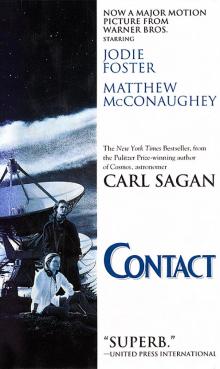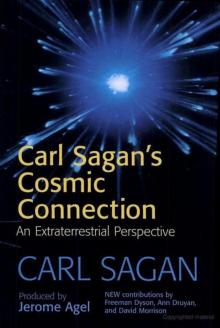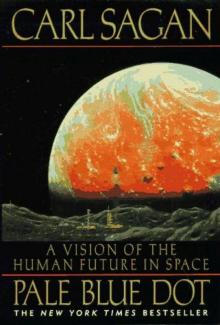- Home
- Carl Sagan
Comet Page 26
Comet Read online
Page 26
If the metamorphosis really occurs, then there might be a few comets caught in transition—in, you might say, their last gasps. They would sputter as they approach the Sun, the final bare patches of ice vaporizing and the lag deposit enforcing quiescence everywhere else. There are such comets, and, if you observe assiduously, you can sometimes catch them in their quiescent phase. Some comets show no decline in brightness even after ten or more perihelion passages, but others tend, after a while, to fade steadily into inconspicuousness. Take Schwassmann-Wachmann 1, for instance, although it may be very far from extinct. There is no question that it outgases like a comet: the diffuse coma is at least on occasion clearly seen, and even the emission lines of CO+ have been observed. Schwassmann-Wachmann 1 seems to show more coma activity when it is closer to the Sun than when it is farther away. But when it is quiescent, it has the brightness and color of an RD-type asteroid—so-called because it is red and dark from the complex organic molecules it contains. A number of active comets, observed far from the Sun before substantial comas form, also resemble RD asteroids—including Halley’s Comet, seen in 1985 when it was near the orbit of Jupiter. Other intermittently active comets—Arend-Rigaux, for example, or Neujmin—when quiescent resemble S-type asteroids, grayer, made mainly of silicates and metals, but still quite dark. It seems clear that when such comets complete their outgassing, they will be indistinguishable from asteroids.
Asteroids collide with one another and occasionally a fragment is broken off and finds its way to the Earth’s surface, where it often ends its days in a museum, catalogued as a meteorite. There are many different kinds of meteorites. Some have never been heated very much in four and a half billion years, contain complex organic matter, and somewhat resemble the cometary fluff that is collected in the stratosphere. Some of these carbonaceous meteorites could conceivably be of cometary origin, arising from collisions with asteroids or other causes of cometary fragmentation. Indeed, the color and darkness of RD asteroids is like that of the organic-rich clays found in carbonaceous meteorites.
Other meteorites, though, show very little organic content, and are made mainly of stone, or even metal. Some stony meteorites might arise from collisions with asteroids like the one Comet Arend-Rigaux is on its way to becoming. The huge iron meteorites proudly displayed in museums throughout the world tell a story of great heat, melting, and coalescence of molten iron droplets into a large mass before the whole thing cooled. In their history, the iron meteorites have been so strongly heated and reworked that they cannot possibly be unaltered, primordial cometary stuff. The same is true, although to a lesser extent, of the stony meteorites. But the carbonaceous meteorites are much closer to the primitive matter from which the solar system formed.
Many of the asteroids originated roughly where they are right now—mainly between the orbits of Mars and Jupiter. They may be the remnants of the rocky (and metallic) bodies that, along with some cometary matter, accreted to form the Earth and the other terrestrial planets. They must be the source of many meteorites. But interspersed among them, traveling incognito, cunningly disguised, are comets. They’ve put on an overcoat of dust, or stripped down to some hidden core. Unless you look quite closely, you might never notice that there are blue-jay eggs in the robin’s nest. A few asteroids even have cometary sorts of orbits—highly elliptical, carrying them near Mars, or the Earth, but especially near Jupiter. One such asteroid is called Hidalgo, of the RD class. Perhaps because of the rocket effect (Chapter 6), Comet Encke is slowly walking its orbit inward. There is abundant evidence that Encke is falling to pieces—including the Taurid and Beta Taurid meteor showers which it trails.
One of these suspect asteroids, Phaeton (1983 TB), was discovered by the Infrared Astronomy Satellite (Chapter 12) in 1983, and shares its orbit with the meteor stream responsible for the Geminid meteor shower every December 14. It is extremely unlikely that 1983 TB would find itself exactly in the Geminid meteor stream by accident, and it is equally improbable that it is an asteroid that just before we started observing it was fragmented by collision. It is probably a piece of an extinct comet. The Geminid meteors are known to be stony, not fluffy, material. As with comets like Arend-Rigaux, there is a hint here that comets can metamorphose into true rocky asteroids. Thus, when we find a crater on Earth with evidence that the impacting body was made of rock, it may nevertheless have been generated by an extinct comet.
Asteroid Oljato may be another comet with an identity crisis. Its highly eccentric orbit, stretching from Jupiter to Venus, is comet-like. It reflects light at visible and at radar wavelengths in an entirely anomalous way; no other object in the solar system looks like Oljato. And it seems to be associated with one of the meteor showers. Oljato has also been detected in an unusual way: In orbit about the nearest planet is an American spacecraft called Pioneer Venus, which, among its other duties, is busily recording day-by-day the strength of the local magnetic field. There is a steady background field, and occasional anomalies. About a quarter of the magnetic disturbances that have been detected occurred when Oljato passed very close (within 1.3 million kilometers) to Venus and its attendant spacecraft. Asteroids are not expected to have detectable magnetic fields. But if Oljato is a slightly active comet, it would generate a thin coma. The coma would be quickly ionized by solar ultraviolet light and would in turn compress the magnetic field carried by the local solar wind. As this compression passed by Venus, an intensification of the local magnetic field might be detected. Oljato’s strange spectrum suggests it is something rare, but several other pieces of evidence strongly imply it is a comet at death’s door.
Adonis is another suspect asteroid, on a very elliptical comet-like orbit that crosses the Earth’s orbit. Its radar echo has peculiar properties that may be explicable if its surface layers are highly porous—as if the ice has all been vaporized, leaving only a loosely bonded matrix of dust.
Every year, on average, there is a new recruit to the ranks of the short-period comets, dragooned from longer period orbits by Jupiter’s gravity. Aided by sunlight, gravitational tides, and rotation, many of these comets fall to pieces and vanish altogether. Others are ejected from the solar system or run into worlds. But a steady population is apparently metamorphosed into asteroids, with orbits ranging from near-circular to highly elliptical. Over the age of the solar system, the number of the comets thus disguised must become quite large.
Many asteroids that cross the Earth’s orbit are probably extinct comets. Because they tend to be small and dim, they are hard to find. There are fewer than a hundred objects known to cross the orbit of Mars or Earth, and this is after a decade of intense searching. These Earth-approaching asteroids are of particular interest to us, because they represent something with serious and calculable consequences: the high-speed collision of an object kilometers across with the Earth would represent a major catastrophe, of a sort that must have happened from time to time during the history of the Earth. It is a statistical inevitability. And while we may describe the Earth as having been hit by an asteroid, we recognize that the falling body may have been a comet in disguise.
From the observed population of comets today, and the cratering record, it is even possible to estimate how many comets or asteroids and of which kind have excavated the craters on a given world. Eugene M. Shoemaker is the founder of the U.S. Geological Survey’s Branch of Astrogeology; one of the scientists behind the earliest serious work in America to explore the Moon; responsible for the discovery of many near-Earth asteroids; and the world expert on Meteor Crater, Arizona. He is also codiscoverer of the famous Comet Shoemaker-Levy 9, discussed in the next chapter. Shoemaker combines down-here geology with up-there astronomy. With his collaborator, Ruth Wolfe, he has estimated that something like a quarter of the craters seen on the big moons of Jupiter are produced by the long-period comets. Perhaps another quarter are due to active short-period comets—ones that are still producing copious dust tails, outbursts, brightness changes and the like. Fully half the cra
ters are dug out by non-cometary bodies, including extinct short-period comets disguised as asteroids. For the Earth, about a third of recent craters are due to the long-period comets, not very different from the story on Jupiter’s moons. But the remainder of terrestrial craters are due to Earth-approaching asteroids, at least some of which are extinct comets. Here, according to Shoemaker and Wolfe, the known short-period comets make little contribution to cratering.* Because their aphelia are near to Jupiter through the circumstances of their capture, the short-period comets much more often run into the moons of Jupiter than they do the Earth.
When a big comet or asteroid strikes a small world, which sometimes happens, the world may be destroyed, smashed to bits. This almost happened on Phobos, a moon of Mars (Chapter 7), and to Mimas, a moon of Saturn. Large comets were abundant in the early history of the solar system, and as they were being incorporated into the growing moons and planets, catastrophic collisions happened often.
On the Moon and Mars and the large satellites of Jupiter, there is evidence of enormous ancient collisions that produced not craters, but basins hundreds or even thousands of kilometers across. In one promising theory, the Moon itself was born from a massive impact of some failed small planet with the Earth, the ejected fragments from the collision coalescing to make our natural satellite. The scar has healed long before now, but if that collision had been somewhat more energetic, the Earth might have been destroyed altogether, and we would not be here, attempting to decipher the evidence of our origins.
The spacing between the worlds, their masses, and even their survival depended on how many primitive bodies were moving on what orbits in the early solar nebula; that is, on the chance concatenation of a multitude of events, some probable, others less so. Start the solar system over again, let only random factors operate, and there will be a slightly different collection of rocky and icy bodies formed, each a few kilometers across; another sequence of collisions building new worlds; an altered number of planets, with somewhat different masses and orbital positions. We used to think that in general the rocky terrestrial planets will be on the inside, and the gas giants still on the outside. Plus icy and organic moons, and the comets in a great cloud beyond. But in the 1990s an extraordinary sequence of discoveries has been made, showing that a number of nearby stars have giant or Jovian planets as close as the Earth is to our Sun or even closer. There may be dozens of different categories of planetary systems, each with their own disposition of comets. There also may be a vast multitude of planetary systems in the Galaxy that look roughly like our own, and others with significant differences from type to type and system to system, depending on the complex collisional roulette that shaped their origins.
Comets rework the surfaces of worlds, carry volatiles to parched planets, dig up buried treasures for the planetary scientists, and leave a record of their history throughout the solar system: they are busy, useful, obliging bodies. But comets also make worlds and destroy them. They remind us of the time some 4.5 billion years ago when the planetary system was made of nothing but comets and their rocky equivalents, hundreds of trillions of them or more, swarms of bodies merging and smashing, careening from one district of the solar system to another, a whirlwind of small worlds that eventually led, after the impetuosities of youth had subsided, to the present staid machinery of the solar system. The occasional passing comet is, these days, one of the few reminders of our violent and chaotic origins.
*This is very close. If you had been standing on the Comet of 1680—or a little above it so you could see out—you would have discovered that the Sun filled half your sky. And in more than one respect, you would have been inside the Sun.
*B. G. Marsden, “The Sungrazing Comet Group,” Astronomical Journal, Volume 72, page 1170, 1967.
*From Poynting’s Friday-evening discourse at The Royal Institution, “Some Astronomical Consequences of the Pressure of Light,” May 11, 1906.
*On this point, experts differ; some believe that active short-period comets may be quite important for terrestrial cratering.
CHAPTER 15
The Wrath of Heaven:
1. The Great Dying
A comet never descends all the way to the lowest regions of the atmosphere, and does not approach the ground.
—SENECA, NATURAL QUESTIONS, BOOK 7, “COMETS”
Comets are such beings as have been on account of their merits raised to heaven, whose period of dwelling in heaven has elapsed and who are then redescending to Earth.
—AL BIRUNI, ELEVENTH CENTURY
She first beholds the raging comet rise,
Knows whom it threatens, and what lands destroys.
—JUVENAL, THE SIXTH SATIRE. TRANSLATED BY JOHN DRYDEN.
Comets striking Jupiter are not abstractions of astronomers. Neither are they exceptionally rare events. The world was transfixed when, on March 25, 1993, a small band of comet and asteroid hunters was amazed to find some twenty small, bright objects that no one had ever seen before all orbiting Jupiter. They were in a regular procession, one behind the other. Collectively these cometary fragments are called Shoemaker-Levy 9, after their discoverers. Originally they were probably components of one larger comet that was tidally disrupted on repeated close passes by the giant planet. By plotting their orbits into the future it soon became clear that each of them was about to crash into Jupiter one by one, each behind the other. Between July 16 and July 22, 1994, all of them did so. The impacts were captured by telescopes all over the Earth, including the Hubble Space Telescope and the Galileo Interplanetary Spacecraft on its way to Jupiter. As luck would have it, the impacts were just over the horizon, as seen from Earth, but the brilliant plumes swelled up almost instantaneously. The temperature of the resulting short-lived fireball was thousands of degrees.
Each of the cometary fragments of Shoemaker-Levy 9 is estimated to have been a few hundred meters to perhaps a kilometer across, plummeting into Jupiter at 60 kilometers a second. A remarkable fact—predicted by almost no one—is that every impact left a dark blemish about the size of the Earth. Each blemish took weeks or months to fade. That a high-speed comet, no bigger than a football field, could produce an effect the size of the entire planet Earth is something worth pondering.
We see that comets can hit the nearby planet Jupiter during our lifetimes. And we know that they have hit worlds throughout the solar system during its entire history.
The star which rules thy destiny
Was ruled, ere earth began, by me:
It was a world as fresh and fair
As e’er revolved round sun in air;
Its course was free and regular,
Space bosom’d not a lovelier star.
The hour arrived—and it became
A wandering mass of shapeless flame,
A pathless comet, and a curse,
The menace of the universe …
What wouldst thou, Child of Clay, with me?…
The comets herald through the crackling skies;
And planets turn to ashes at his wrath.
—LORD BYRON, MANFRED, I, I, 118 AND II, IV, 381, 1816
The ground is growing. Silt settles onto the stream bed, dust falls from the air, and the ground is a little higher. A pretty typical rate of growth is a micron a year—a film at most one microscopic particle thick, an almost imperceptible patina settling annually over the surface.* A micron is almost nothing. But over geological time, it adds up. In 10,000 years, at this rate, you build up a centimeter of the stuff, and in a million years, a meter. If you could find a place where, over a good part of the age of the Earth, material was only added, and never removed, you might discover cliffs kilometers high in which an undisturbed record of the history of our planet is preserved.
Providentially, there are such places; one of the best known is the Grand Canyon of North America, where the sedimentary column has been exposed by the slow but persistent erosion of the Colorado River, and the uplift of the Colorado Plateau. You see a lovely pattern in the
rocks, a sequence of muted pastel layers. In adjacent cliff faces, there are almost identical patterns. Each layer is an epoch. Every boundary between layers corresponds to some major change in the environment. If the sedimentary columns show the same pattern everywhere, the environmental changes must have been worldwide. As you glance from the top to the bottom of such a cliff, you see the history of the world. You have only to step up and read.
An ammonite from the Cretaceous seas. Because they made abundant fossils the shapes of ammonite shells are known very well. Drawings on this page, this page, this page, and this page by Maren Leyla Cooke.
Without doing any digging at all, you might see something bright gleaming in the sunlight. You examine it more closely and realize it’s a fossil, perhaps a dinosaur’s knee, or the jaw of an armored fish. With a microscope, you easily discover fossils of little creatures, perhaps single-celled plankton that floated in some primeval sea. You look elsewhere, at other sedimentary columns, and the remarkable thing is that everything goes together. This particular thick, reddish deposit tends, in many places, to be underneath these two thin gray layers; it always has a similar mix of fossils. The rocks corresponding to a given epoch may differ from site to site, but the abundant fossils are always the same. You find an ammonite shell and it confirms that the vast desert landscape of which this cliff is part was once the bottom of an ocean. A few meters above or below, and the fossils look very different; you realize that if you wait long enough, the landscape will change dramatically.
The rocks are trying to tell us something. These fossils are the only remains of creatures that once strode or slithered or swam or just took root, beings that arose and died out long before there were any humans to take note of them. You take a particular fossil and, all over the world, there is a layer—corresponding to some epoch in the past—below which that organism had not yet come into being. Generally, there is a layer above, in which that fossil no longer appears; but the fossils of new organisms are there found for the first time. The lesson is clear: Great numbers of species have become extinct, providing opportunities for other species to evolve and fill the vacated ecological niches. Many of these species were too small to be seen without a microscope, although some were as big as an office building. You count up all the beings that leave fossils and you discover that the vast majority by far of all the species that ever lived are now extinct. Extinction is the rule. Survival is the exception.

 Cosmos
Cosmos Murmurs of Earth
Murmurs of Earth Broca's Brain
Broca's Brain Comet
Comet Contact
Contact Dragons of Eden
Dragons of Eden Cosmic Connection
Cosmic Connection Shadows of Forgotten Ancestors
Shadows of Forgotten Ancestors Billions & Billions
Billions & Billions Comet, Revised
Comet, Revised Broca's Brain: The Romance of Science
Broca's Brain: The Romance of Science The Varieties of Scientific Experience: A Personal View of the Search for God
The Varieties of Scientific Experience: A Personal View of the Search for God The Cosmic Connection
The Cosmic Connection Pale Blue Dot: A Vision of the Human Future in Space
Pale Blue Dot: A Vision of the Human Future in Space The Dragons of Eden
The Dragons of Eden